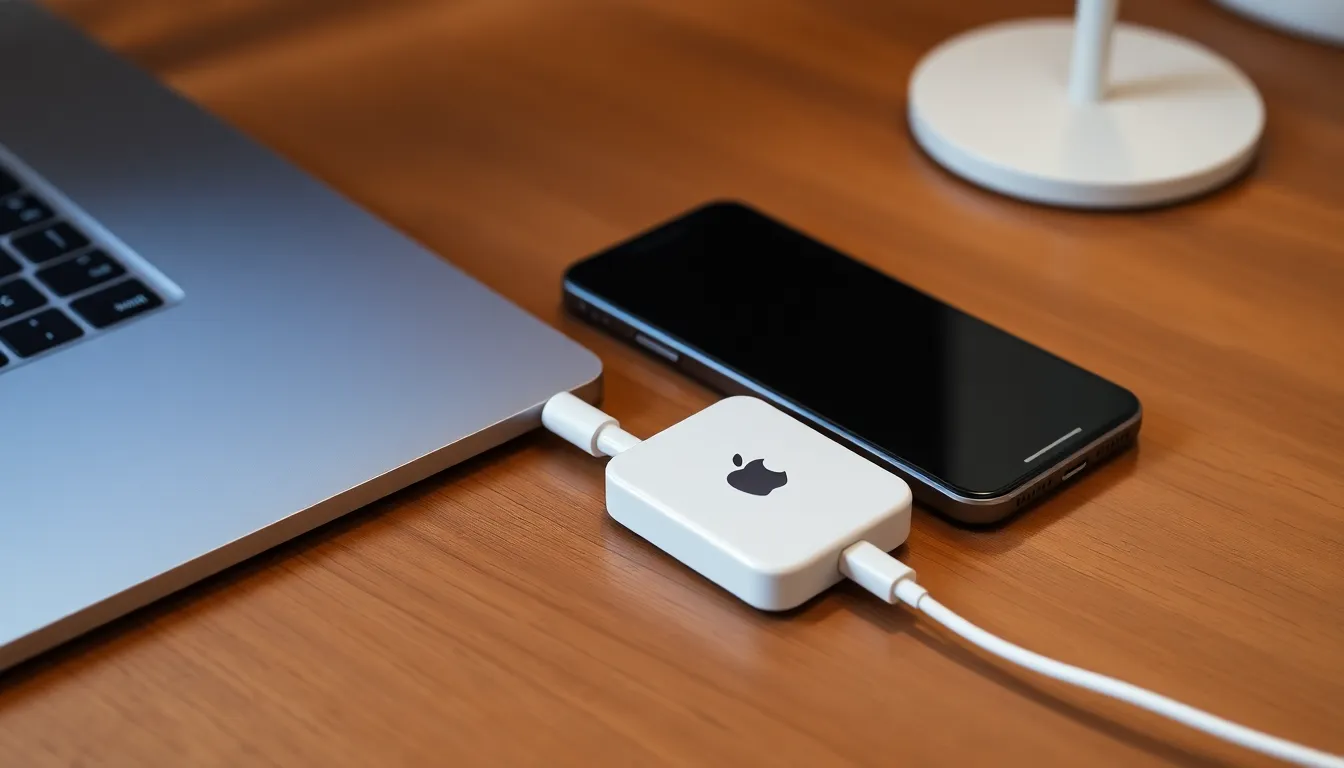Table of Contents
ToggleIn a world where chargers seem to multiply like rabbits, it’s easy to wonder if that hefty MacBook charger can rescue your iPhone from the dreaded low battery warning. After all, who wouldn’t want to power up their phone faster than a caffeinated squirrel? But before you make that leap of faith, let’s explore whether this tech duo can really play nice.
Can You Use MacBook Charger for iPhone?
Using a MacBook charger for iPhone charging is possible and may even offer faster charging speeds. MacBook chargers, particularly those with USB-C connections, provide higher wattage compared to standard iPhone chargers. A typical iPhone charger delivers 5W to 20W, while a MacBook charger can range from 30W to 100W.
Higher wattage doesn’t harm iPhones, as the devices will draw only what they need. Safety mechanisms in iPhones prevent overcharging and battery damage. Many users find the convenience beneficial, especially when they need a quick battery boost. Moreover, the compatibility between USB-C iPhone models and USB-C MacBook chargers enhances versatility.
Using a MacBook charger can reduce charging time significantly. For example, charging an iPhone 13 can achieve up to 50% battery in around 30 minutes with a compatible MacBook charger.
Charging efficiency is notably higher when leveraging fast charging capabilities. However, it’s important to use certified cables to maintain safety and performance integrity. Non-certified cables could lead to slower charging or damage.
Apple emphasizes using genuine accessories for optimal performance. If an iPhone user prefers using a MacBook charger, ensuring that it’s an official Apple product or MFi-certified is advisable.
Ultimately, combining a MacBook charger with an iPhone proves functional, efficient, and beneficial in various charging scenarios.
Benefits of Using a MacBook Charger for iPhone

Using a MacBook charger for an iPhone delivers several advantages, enhancing convenience and efficiency.
Faster Charging Times
Charging an iPhone with a MacBook charger leads to noticeably faster charging times. For instance, many users experience a 50% battery increase within just 30 minutes when using a compatible MacBook charger. Regular iPhone chargers typically provide 5W to 20W, while MacBook chargers deliver between 30W and 100W. Charging at higher wattage doesn’t harm the iPhone, as the device regulates power intake. Built-in safety features protect against overcharging, ensuring the battery remains healthy. Fast charging enables users to quickly power up their devices, making it especially useful in time-sensitive situations.
Convenience of Dual Use
Utilizing a MacBook charger for an iPhone offers notable convenience for users with both devices. One charger can serve multiple purposes, reducing clutter from various charging accessories. Many find it practical to use the same cable and charger for both iPhone and MacBook, streamlining the charging process. USB-C compatibility enhances this duality further, as newer iPhone models support USB-C connections. Switching between devices becomes seamless, enabling users to charge their iPhones without carrying extra equipment. This versatility simplifies daily routines, creating a more efficient charging experience overall.
Compatibility Considerations
Understanding compatibility ensures that using a MacBook charger for an iPhone is both safe and efficient. Users can benefit from the flexibility of their devices.
Power Output Differences
MacBook chargers deliver significant power output ranging from 30W to 100W. In contrast, standard iPhone chargers typically provide between 5W and 20W. This difference enhances charging speed, particularly for newer iPhone models supporting fast charging. When charging an iPhone with a MacBook charger, the device draws only the required power. Charging time can dramatically decrease, with an iPhone 13 reaching 50% battery in approximately 30 minutes.
Charging Cables and Adapters
Using the right charging cables is essential for maximizing compatibility and performance. Apple encourages users to use certified cables to prevent issues associated with slow charging or potential damage. MFi certification indicates that accessories meet Apple’s performance standards. Genuine Apple products or MFi-certified cables ensure optimal charging efficiency and safety. Standard USB-C cables work well with both devices, simplifying the charging process for users who own both a MacBook and an iPhone. This versatility contributes to a streamlined charging experience across devices.
Safety and Risk Factors
Using a MacBook charger with an iPhone presents specific safety considerations that users should be aware of. Understanding these risks helps ensure a reliable charging experience.
Overheating Concerns
Overheating is a potential issue when using a MacBook charger for an iPhone. Although MacBook chargers provide higher wattage, iPhones draw only the power they require. This built-in safety feature minimizes the risk of overheating during charging. However, using non-certified cables can increase the likelihood of overheating. Users must monitor their devices for excessive heat, especially with frequent use of powerful chargers. Ensuring proper ventilation and avoiding the use of protective cases while charging can further reduce overheating risks.
Battery Life Implications
Battery life can be impacted by the method of charging. Frequent use of high-wattage chargers, such as a MacBook charger, may not necessarily shorten battery lifespan. Apple’s battery management systems protect against damage from higher power inputs. Still, using certified chargers and cables maintains optimal battery performance. In the long term, users should avoid consistently relying on high-wattage charging to prevent any potential wear on battery cells. Balancing charging habits with standard iPhone chargers alongside occasional fast charging optimizes battery health.
Using a MacBook charger for an iPhone can significantly enhance the charging experience. The higher wattage allows for faster charging without risking damage to the device thanks to built-in safety features. This compatibility not only simplifies daily routines but also reduces clutter by allowing users to rely on one charger for multiple devices.
While it’s convenient to use a MacBook charger, ensuring the use of certified cables is crucial for optimal performance and safety. By following these guidelines, users can enjoy the benefits of quicker charging times while maintaining their iPhone’s battery health. Ultimately, leveraging a MacBook charger for an iPhone offers a practical solution for those looking to streamline their charging needs.







